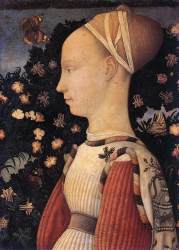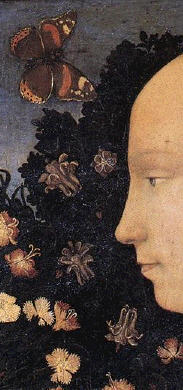On the basis of the above stated opinions one can take a near look at
the documents, if something could be detected, which contradicts our
main interpretations or something, which supports them. Naturally the Trionfi-notes outside of Ferrara are of special importance.
1449:
Scipio Caraffa (appears in Marcellos letter, document
03 ) doesn't know the game (this suggests, that the type of deck
type is new). Marcello himself already knows it and actually Marcello
and Scipio first consider a deck, which is "too cheap for the hands of
a queen" (the existence of this deck indicates an already existing mass
production or production of decks with minor quality).
Marcello is from Venetia/Padua, if one assumes, that the
game spread from Ferrara (near Venetia), his acquaintaince with the new
sort of deck is explainable.
Marcello searches for manufacturers, who could produce a deck (it
seems, he knows more than one, but it is unclear, if this are just
manufacturers for playing cards, who could also produce Tarot cards, if
necessary).
New or not new ? This entry suggests,
that there is already some acquaintance with the deck, but it might be
a "local condition" (Venetia and Ferrara have a distance of ca. 80 km,
if one assumes a small mass production in that region, it doesn't mean,
that this form of new deck already reached Milano outside of the court
- especially since there was war between Venetia and Milano and normal
trade was handicaped).
1450: (Sforza, document 06 ): In Sforzas letter it seems, that
the great duke with all his possibilities has obviously problems to get
a simple Trionfi deck. He's in Lodi, when he writes the letter
(somewhere on the country, 30 km from Milano), not in Milano. It seems,
there is no deck on the country, but possibly in Milano.
New or not new ? It seems clear: In
Milano are not many Trionfi decks (however, there is the plague in
Milano at that time and that might have caused the rarity, see below).
1450 (Florence): A statute allows Trionfi and some other games
after the late 40ies seemed to have been a time of stronger card
prohibition than before. A general theory about Florence and the rest
of Italy assumes, that "in Florence all things were earlier than
everywhere else, there was more creativity". A statute signals a broad
stream of Trionfi cards - in Florence.
But let's look precisely at the situation of 1449 - 1450:
Nov. 1449: Marcello writes his letter. The political situation is
very critical - all eyes watch Milano. Sforza tries to capture the
city. There is famine in the city. Some thousand people will die soon cause of hunger,
before Sforza is successful (Feb./March 1450).
Venetia tries to intervene, but it doesn't work. Florence is happy
after Sforza's victory (Cosimo de Medici had helped Sforza, now there
is a new alliance possible, where 25 years had been more or less war
between Florence-Milano).
Short before Milano had a political experiment: trying to become a
republic 3 long years, getting rid of a reigning duke in 1447 at the
death of the unloved Filippo Maria Visconti. In the case the experiment would have had
been successful, then Milano would have been the 3rd great republic of Italy
beside Florence and Venetia. Under this condition other smaller cities
would have thrown away their reigning nobility soon and the whole course
of renaissance might have become rather revolutionary. This didn't
happen, Sforza reestablished the dukedom in his own interests and
reached a new, relatively peaceful balance between feudalism and
republics.
The anarchical state, that accompanies political changes, gave Sforza
the opportunity to seize the power.
In the year 1450 a plague reached Milano. 30 000 - 60 000 people
(!) died in Milano. Probably that's the reason, why Sforza is not in
Milano, but in Lodi. And the relatively chaotic conditions in the city:
a. death of Fillipo Visconti in 1447, the funeral ended in a revolt
b. 3 years Ambrosian republic
c. with a 3/4 year siege + famine + victory of Sforza
d with a plague with horrible much victims later in the year 1450
result in the condition: difficulties to get a Trionfi deck in
Milano. The city is still a little chaotic in this year.
The plague was not only regional, but I've no data, if Florence was
involved. In times of the plague games had a great chance - see the
Decamerone of Boccacchio. In Florence there is in the late 40ies strong
"playing card prohibition". Perhaps with the success of Sforza in
Milano the general context demanded "more liberal laws", so we have a
release for players. Perhaps the plague and the play during the plague
took an influence.
And Florence is a place, where people reacted quickly: In 1377 Florence
was the first city, that prohibited cards.
New or not new? Trionfi might be
new in Florence, although the statute signals: it is well known.
1452: Malatesta writes to the Sforzas, if he could have a
connection to the trionfi producers in Cremona. This means: Malatesta -
probably at that time in Rimini or in militaric mission in the region
of Naples or Florence, far away (that's not totally sure) - invests
considerable engagement to get such a deck. This he probably wouldn't
do, if the Trionfi were reachable all and everywhere.
Local condition in Rimini or Naples (in Florence Malatesta wouldn't
have the problem, one should assume): no Trionfi deck reachable or at
least no quality Trionfi deck reachable. Or Malatesta is a card
gatherer, another possibility.
Local condition in Milano: The Sforzas seem to have solved their card
problem.
New oder not new?
This story tells, that Trionfi are relatively new, still.
And now to Ferrara: although in the years 1450 - 1463 there is
constantly something about Trionfi noted in Ferrara, there is NOTHING
between 1442 - 1449. And the interest seems to develop slowly: 3 decks
are produced in 1450 ( document 04 ) and
one in 1451 ( document 07 ) and that's all
before 1454, when Ferrara tried to start a mass production (in small
dimensions, but the production of ). In concurrence to these
documents appear in Ferrara also notes about the Imperatori deck, which
disappears soon after the raising Trionfi success from Ferrara.
Looking precisely at the first 2 entries from Ferrara 1442 (document 1
and 2): Document 01 starts optimistically
with 4 Trionfi decks,
Dokument 2 speaks of a
deck for two boys, 9 and 11 years old. Additionally the document B points to a creative situation around
1st of January 1441, where the Trionfi deck idea might have been born.
Conclusion out of these contexts: The very early Trionfi in
Ferrara isn't taken serious by adult players and stayed as toys for
younger humans. The court of Leonello (1442 - 1450) didn't show great
interest, instead of this we see a greater interest for Imperatori
decks in 1443 and after that no other document, which might indicate,
that the courtly interest in playing cards generally was very weak
between 1443 - 1450, that means till the death of Leonello. Looking
precisely at all notes of Ferrara, we see a Parisina-phase between 1422
- 1424, a periode of nothing about playing cards after her death till
1434, and then a periode of playing card interests till 1443 with
enough young persons in the right age at the court and then a pause
again till 1450 - perhaps simply cause a desinterest of the regent
Leonello in these years. In 1450 this changes, perhaps with Borso
(although document 4 still happened under Leonello), but the Ferrarese
documents do not reflect "Trionfi-enthusiasm", as one might read out of
the Marcello-letter, the Florence-statute and the Sforza-letters.
Perhaps one can interprete this as "less interested as elsewhere" at
this time, and perhaps this refers to the condition that "around
Ferrara the deck is NOT a novelty".
A subground stream, not watchable to our eyes leads from the Ferrarese
situation in 1442 to a situation in 1449/1450, where some trionfi decks
exist, but this kind of play is not known everywhere and not existent
in great number.
A communication between Pier Candido Decembrio and Leonello after the
death of Filippo Visconti (1447) about Decembrio's "Vita di Filippo
Visconti" gives some further information about the state of Trionfi
decks around that time, compare Ross Caldwells article at Document 28 (Polismagna) and the
special article to the occurence.
There are 6 (perhaps only 4) documents which give informations
about the deck structure of Trionfi decks, 3 of them are fragments of
playing card decks:
- 1. Brera-Brambilla deck: very unsecure in his informative worth, even
allows a 4x14 + 4 - deck
-
2.
Cary-Yale deck: has
24 courts and 56 pips, the number of trumps is unclear, the motifs differ from
the "standard"; probably it had a 5x16-structure)
3. Pierpont-Morgan-Bergamo
deck: The first artist (Bonifacio Bembo) produced (probably) 70 cards
and 14 trumps, all trumps are known.
4. Document B gives more strength to the 5x14-theory, it
speaks of "14 figure" in a very special context.
5. Document 03 :
Marziano describes 16 gods and 4 court cards and 40 pips, with some
insecurities this would be 60 cards totally.
6. Document 16 : 70 cards are
mentioned, probably refering to a 5x14-deck
2 documents and one unsecure document
suggest a 5x14-structure
1 document and an unsecure document suggest experiments with the number
of 16 trumps.
No document really suggests the existence of 22 trump cards.
(autorbis)
Analyses of Documents (2) - spring 2004
in preparation
|
 |


